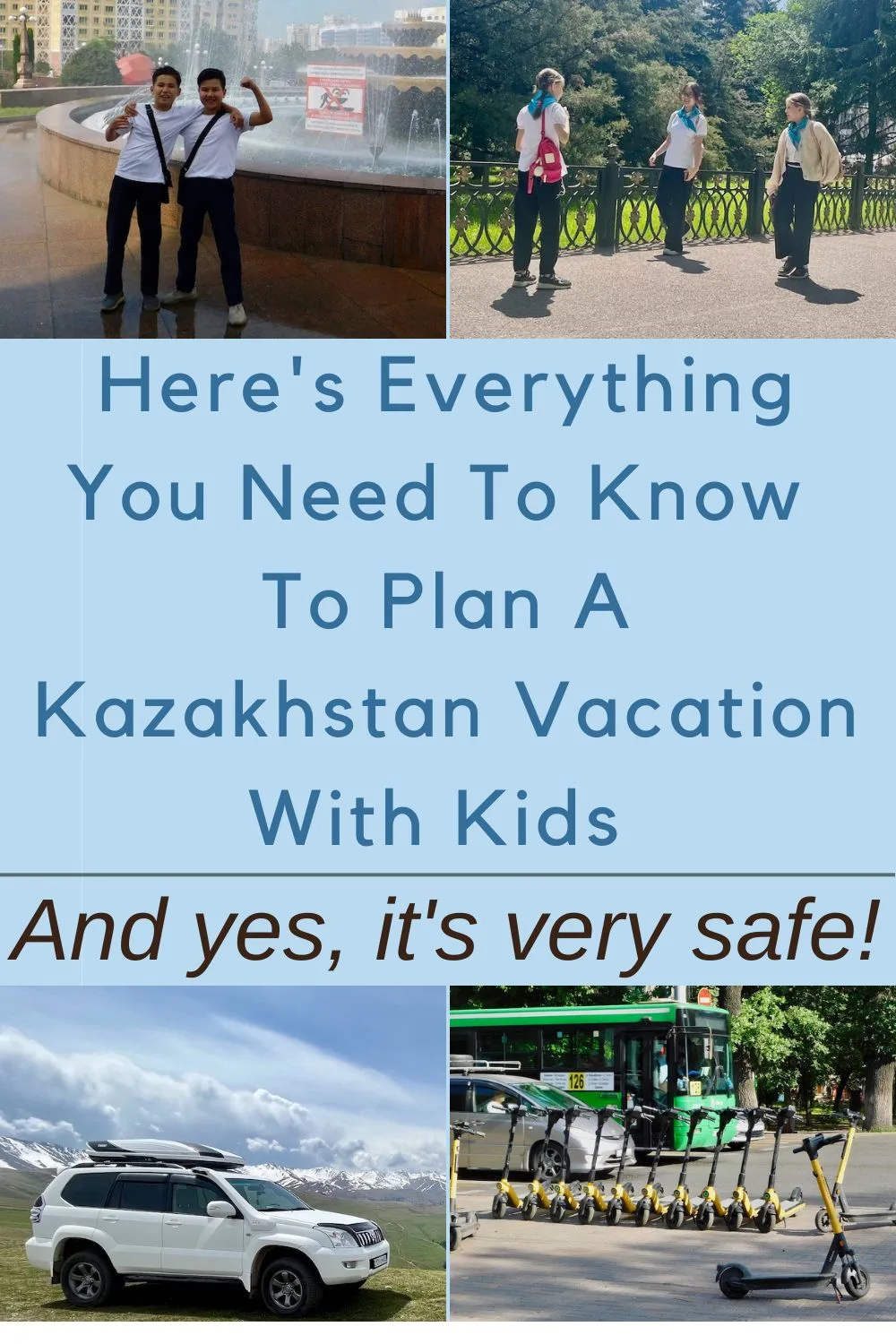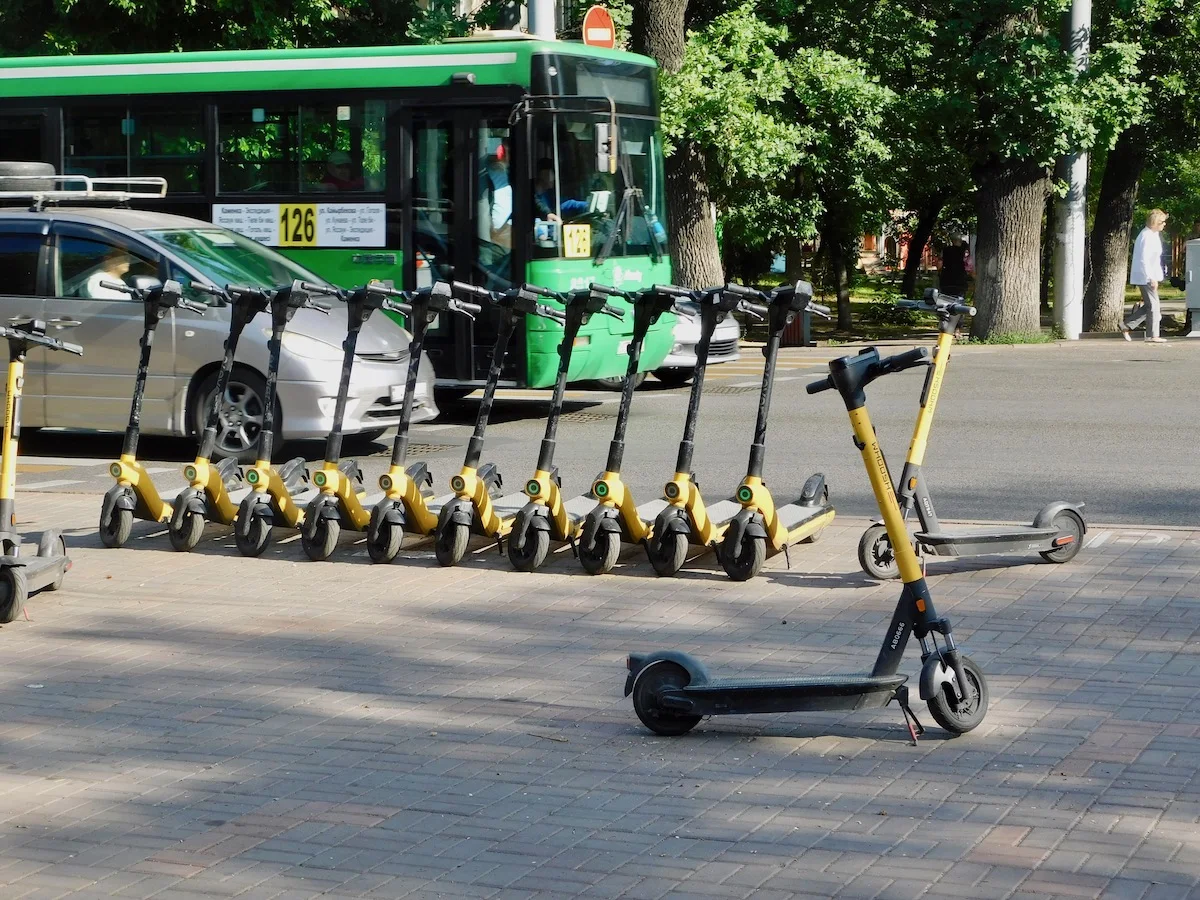I was invited to travel to Kazakhstan as part of a project to develop the country’s tourism. Whenever I told people I was traveling to Kazakhstan they would immediately ask, is it safe? Then they would ask if it’s very poor and if the women are covered from head to toe in burkas.
After I answered those questions quite emphatically: yes, no and no. Some asked if I would travel to Kazakhstan with kids. And my answer to that is, absolutely yes, without hesitation.
Aside from the long plane ride, this country in Central Asia has a lot to offer for a memorable family vacation. Teens will appreciate the cultural exploration better than younger kids. But the clean cities, easy access to outdoor activities and surprisingly accessible food makes it very doable with kids of any age.
Here is all the essential information you might need to plan your family vacation to Kazakhstan. Plus, a packing list at the end of the post that you can download and print.
Read More:
• 25 Things To Do in Kazakhstan With Kids in 10 Days
• Save for Your Dream Vacation in 5 Easy Steps
• 33 Expert Tips for Safeguarding Your Family on Vacation
Your 12 top questions about traveling to Kazakhstan with kids: Answered
Is Kazakhstan safe?
Kazakhstan has a lot of oil, some precious minerals and a fledgling tech industry. The country is prosperous and there is a large middle class in the major cities. I’ve heard the newish capital city of Astana compared to Dubai.
So yes, it’s safe. the U.S. State Department rates it a 1, which means “exercise normal precautions.”
Morever, Almaty, where I was based during my visit, is one of cleanest cities I’ve been to. Boulevards are broad and well-lit, sidewalks are wide and traffic is organized. Also, the subway is new and has police officers keeping an eye on most stations.
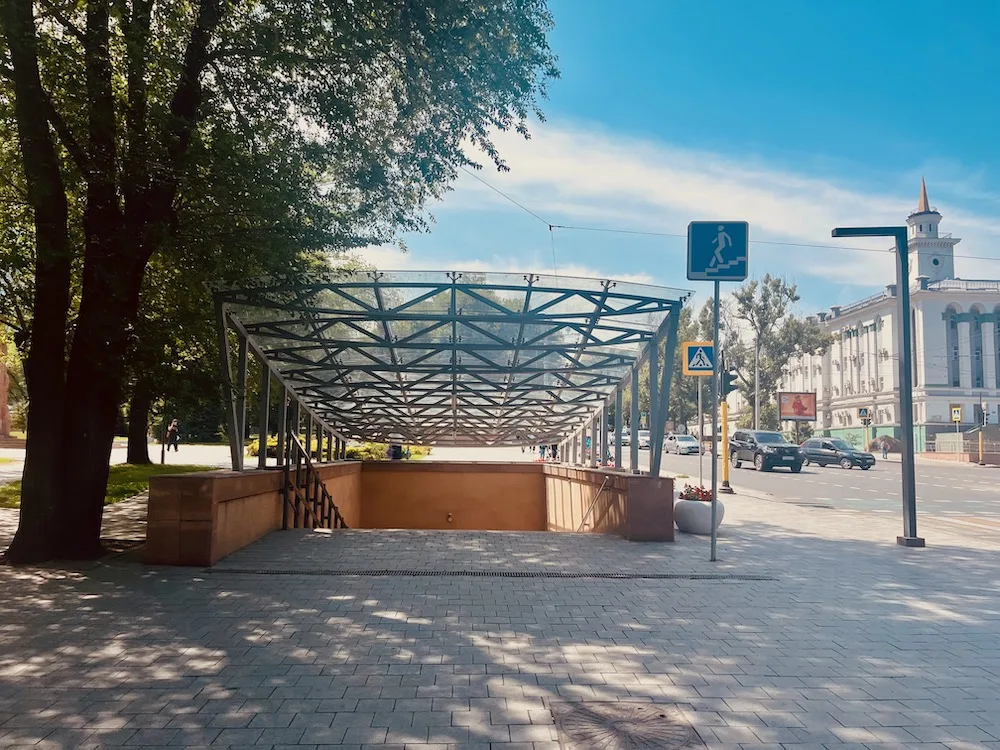
There are a lot of tree-lined streets, public parks and playgrounds. Because I was there at the start of summer vacation there were a lot of families out and about as well.
Tourists from Europe and America are still a bit of a novelty, so If people speak English they might approach you to ask if you’re visiting, where you’re from and if you like Kazakhstan. But after minute of chatting they’ll be on their way.
I split off from my group twice. Once I took a cab, did some sightseeing and walked a good mile back to my hotel with absolutely no worries.
One of our guides told me about a river walk a couple of blocks behind our hotel so I took a walk to see what it was like one morning. There was a wide compact dirt path and a small man-made river beneath a long canopy of trees. There were signs at each exit point to tell you what street it intersected (in Kazak, of course).
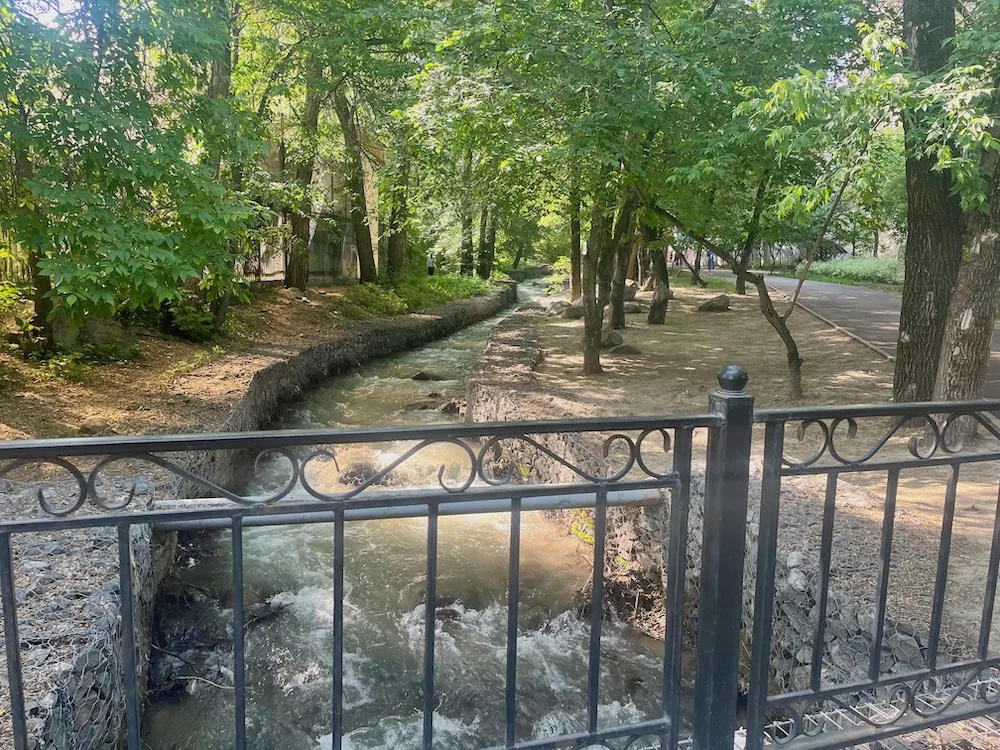
At 8:00 A.M. it was full of joggers, dog-walkers, power-walking retirees and people commuting to work on bikes and scooters, some with their kids along. I passed a playground and a café with a patio that offered great people-watching.
It was an enjoyable peek into everyday life.
What languages do Kazaks speak?
Everyone in Kazakhstan learns Kazakh and Russian. And all the signs and menus are in Kazakh Cyrillic. As part of their effort to become more closely aligned with U.S. and Europe they are transitioning to the Latin alphabet we use, which will make things a bit easier.
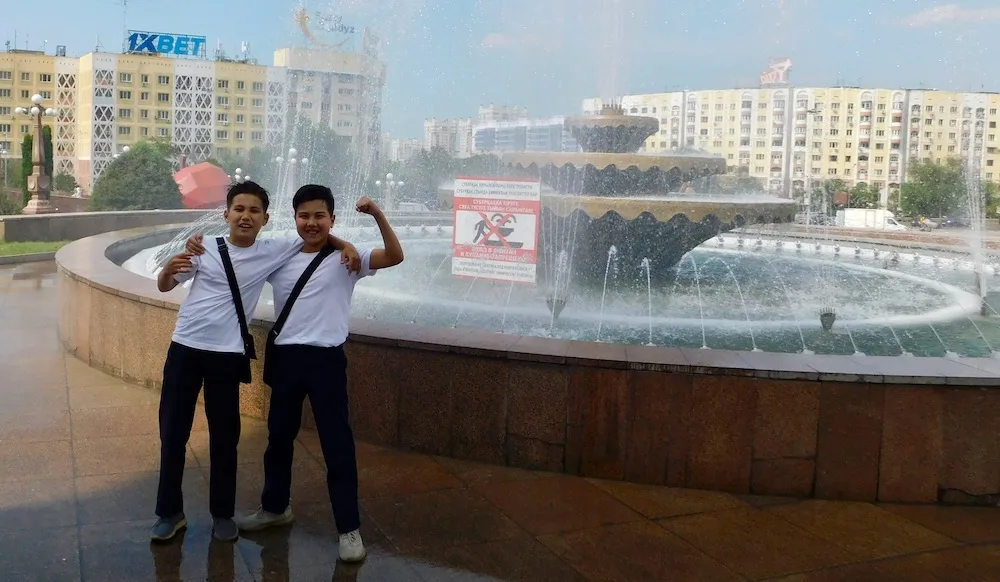
Outside of the tourism industry you won’t find many people over 30 who speak much English. Even among Millennials and Gen Z it’s hit or miss. But kids and teenagers, who have grown up with YouTube and Netflix at their disposal, speak very good English. A few kids even started conversations with me, mostly likely to try their English on a foreigner.
I would say that if you need to ask for direction or help, look for a family. Even if you address the parents, it will most likely be the kids who talk to you.
Also, keep Google Translate handy. A few times I typed English into it and showed people the Kazak.
What Religion do most Kazaks practice?
Some 80% of Kazaks are Muslim. Because Kazakhstan shares a long border with Russia and China, the remaining 20% are largely Russian Orthodox Christian and a small number of Buddhists.
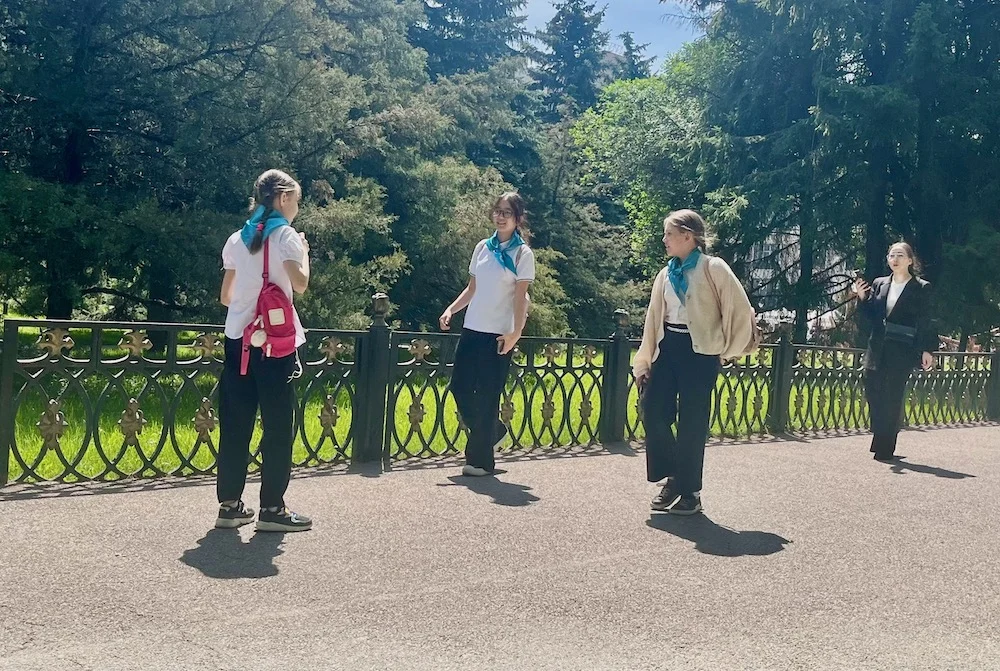
But Kazakhstan very much wants to present itself as a modern secular country. Headscarves aren’t allowed in public buildings and everyone wears Western clothes.
Women are educated and have careers and men have no problem with talking to women. This was especially true in the market, where they all wanted to offer me samples and sell things to me.
How’s the weather?
Like a lot of arid countries Kazakhstan can have extreme temperature fluctuations depending on the time of year and elevation.
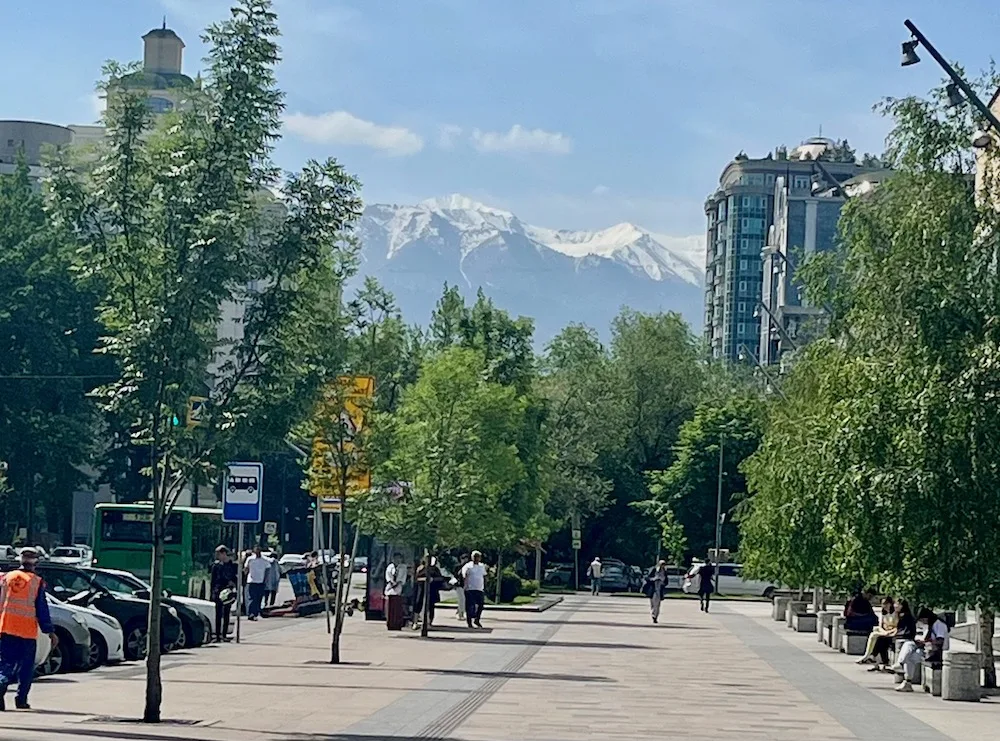
There are some mountains that have ice-covered peaks year-round. But the ski resorts often make their own snow because it’s too cold and dry for real snow to fall. In the cities and valleys temperatures will easily top 100° in the summer and fall well below freezing in winter.
In general the best times of the year to visit are late April through late-June and September through early November, when it’s most temperate and dry.
Did I mention it’s arid? It’s very arid. I was there for about 24 hours and my skin started to feel dry; my eyes often felt dry, too. Stay as hydrated as you can, pack lots of moisturizer and consider saline eye drops.
So, what clothes should I pack for Kazakhstan?
Women dress quite fashionably, but you won’t see cropped tops, tank tops or shorts. Convince your teen to leave those items home because wearing them will generate stares, not to mention disapproving looks from older women.
For sightseeing in the city the women in my group wore skirts and dresses that came below the knees, light loose pants and capris with light shirts with short or three-quarter-length sleeves. Other people wore sneakers, but I found them hot and lived in my sport sandals. I put on a light sweater if we were sitting outside at night.
We carried scarves with us in case we wanted to step into a church or mosque, where they are required, and where people of all ages dress conservatively.
The guys stuck to light khakis and cargo pants and a few wore cargo shorts when we were doing outdoor activities. Women can wear hiking shorts, too, but even then I’d keep them on the longer side.
For hiking and horseback riding I wore sneakers, light hiking pants and a long-sleeve shirt with built-in UV protection.
Many of us also packed jeans and medium-weight fleeces or hoodies for the nights we spent in the mountains, where temperatures can drop quite a bit at night. Through May and after August a vest or light puffer jacket and light winter hat and gloves are a good idea, too.
What sort of foods do they eat in Kazakhstan?
Kazaks eat a lot of meat and bread, which would have made it very easy for me to feed my child even in her most finicky years.
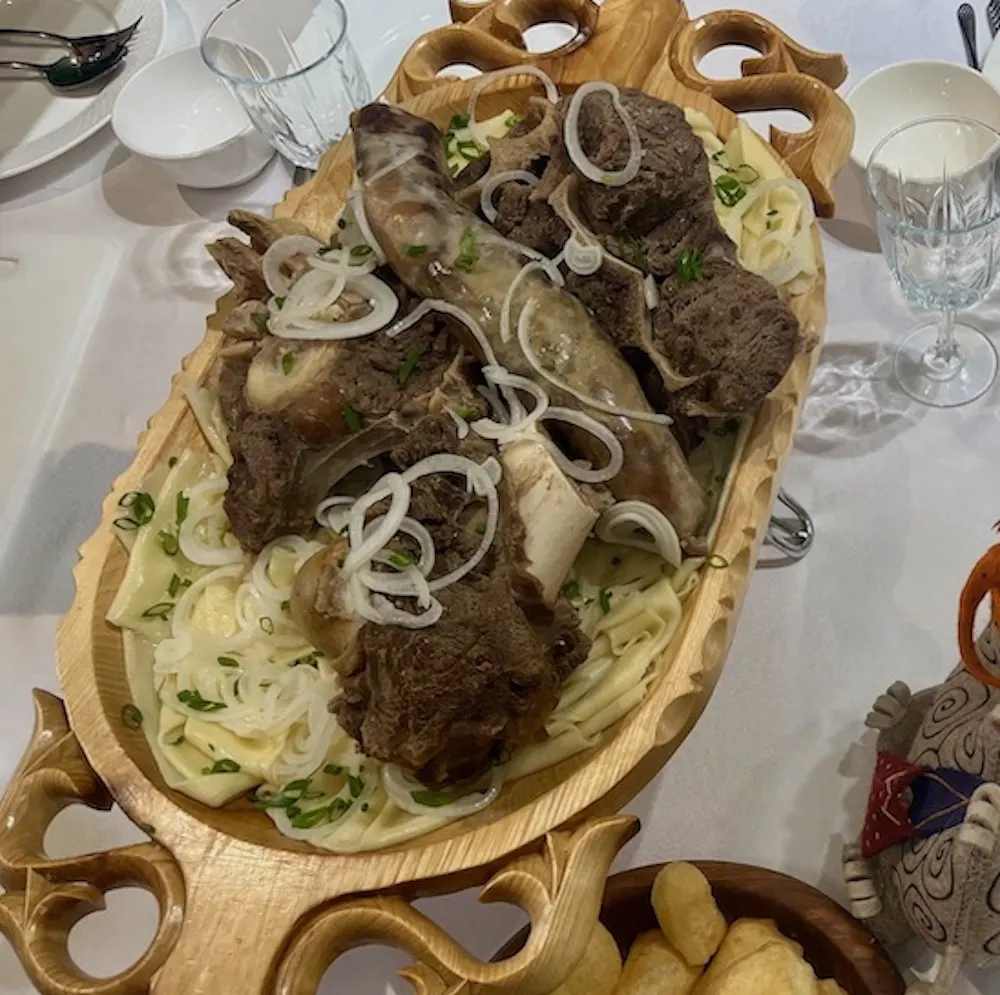
You’ll see beef everywhere. Flaky pastry pockets called samsa were often filled with chicken. Other breads were filled with beef. I had lamb a few times, particularly in kebabs. Horse meat and milk are an important part of Kazakh culture and you’ll find it on many menus.
We had horse meat or lamb with handmade noodles cooked in broth (I liked this dish with lamb quite bit). We also had horse meat tossed into rice pilafs and made into fresh and dried sausage.
Once you get past the idea that you’re eating horse it’s actually not bad. It’s leaner and a bit stronger in flavor than beef, somewhat similar to venison or other red game meat. I liked the garlicky cooked sausages better than the dried ones. And the easiest way to introduce yourself to it is in a rice pilaf.
They also eat different kinds of bread that are typically fried or baked on the side of a wood-fired oven. You’ll see flat breads, puffy breads and small rolls, but not sliceable loaves.
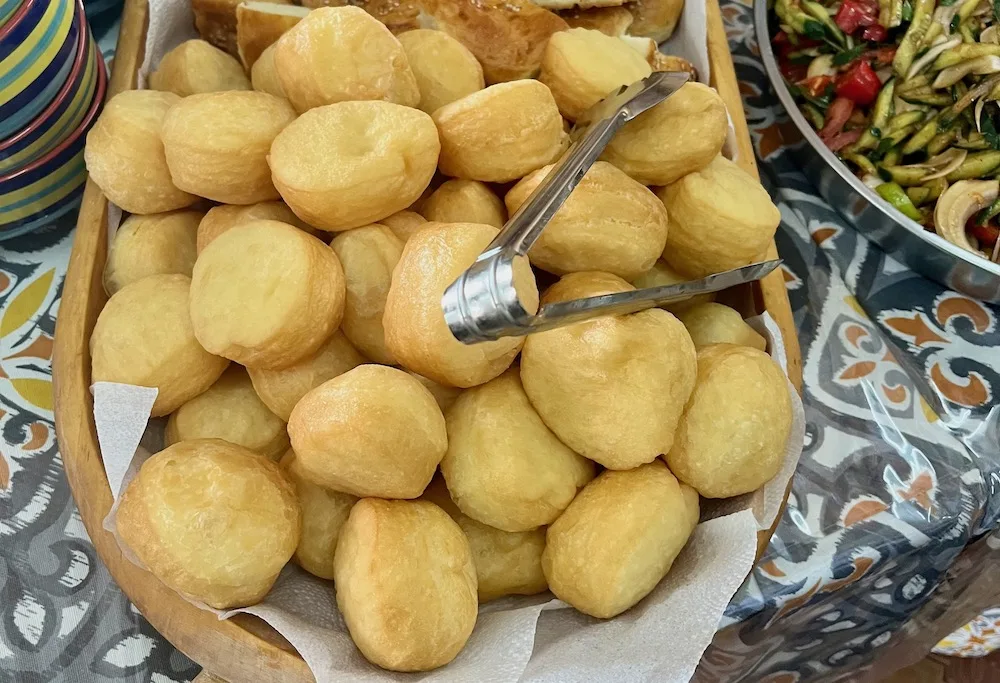
Every meal we had included baursak, which varied in different parts of the country but are always fried and always good. I liked the ones that were the size and shape of American biscuits but much lighter. Others were square and pillowy and tasted like zeppole or funnel cake without the powdered sugar.
We all ate many more of these than was good for us. The baursak alone are a guarantee that your kids won’t go hungry while you’re in Kazakhstan.
There is a lot of dairy, too, from cows, horses and camels. You can easily find yogurt and cheese. A lot of sweets are made with cow or horse milk that is boiled down to a sweet, condensed milk or caramel.
They use sweet cheese in baking. A few pastries that I expected to have whipped or pastry cream had the sort of cheese you’d find in a Danish, which was sometimes good and sometimes disappointing. We had very, very good cheesecake one night.
Almaty is derived from the Kazakh word for apple and the city was once full of apple orchards. So you’ll see apples in their baking, too, as well as pistachios and chocolate.
The horse milk is fermented, which makes it tastes tangy and somewhat like goat cheese. You ought to try it if you have the opportunity, but it’s an acquired taste to say the least. Camel milk isn’t fermented and just tastes like sour milk. Unless you’re a person who has to try everything you can skip it.
If your hotel has a breakfast buffet, ask for cow milk for your coffee and tea. I accidentally used horse milk one morning and it tasted like I’d added goat cheese to my coffee, which was as bad as you might expect it to be.
What can vegetarians eat?
It’s possible to travel in Kazakhstan as a vegetarian, but I think for a vegan it could be challenging.
You can certainly eat many of the breads and ask for rice pilafs without meat. We also ate Asian-style hand-pulled noodles, which are common and which you can ask for without meat or broth. In the cities you can find Chinese, Indian and even Italian restaurants, which will offer vegetarian options.
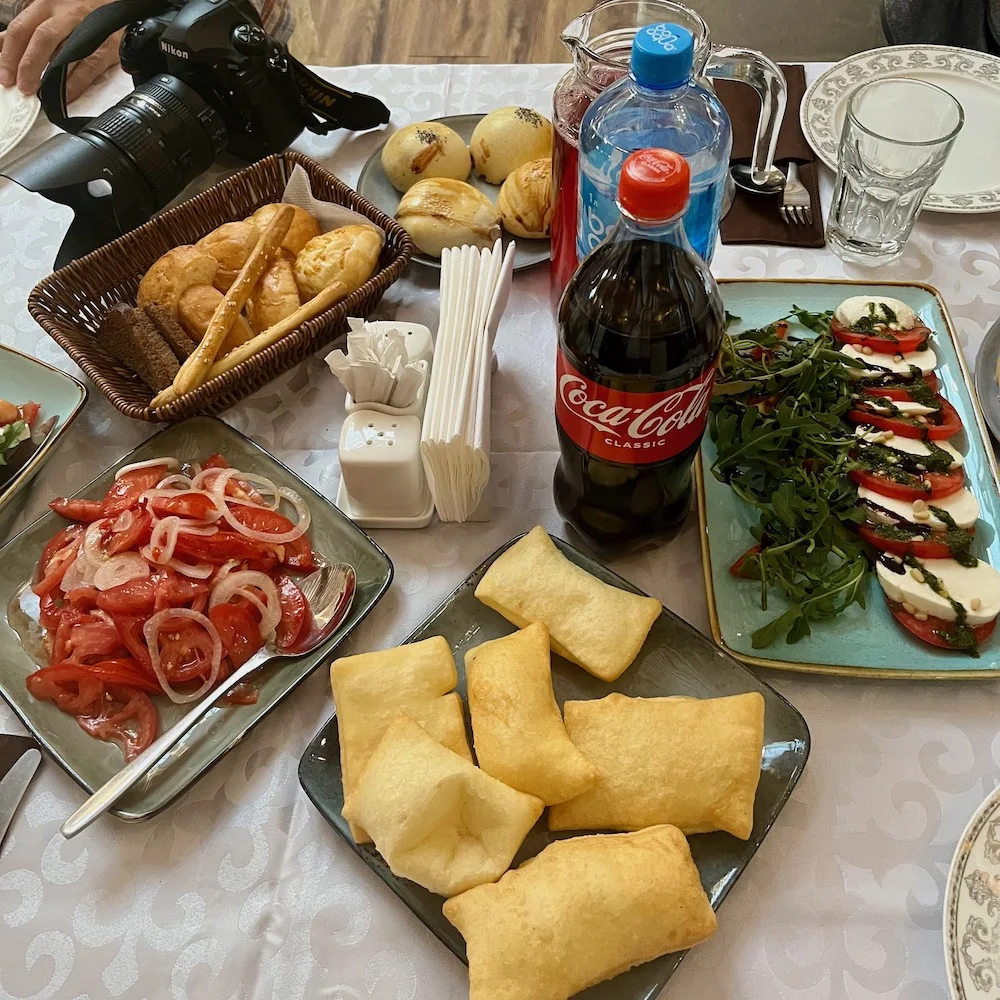
We encountered a good variety of fruit juices and most of our meals included carrot salad and one or more tomato salads. They were good but the person in our group who doesn’t eat red meat said they became repetitive quickly.
There were usually scrambled and hard-boiled eggs at our hotel’s breakfast buffets. You’ll find yogurt at breakfast buffets and in supermarkets.
We had fried local trout twice, so pescetarians can look for that. We had a good lentil soup with lunch once, but otherwise I didn’t see much in the way of dal, beans or chickpeas.
You can go to a city’s central markets to stock up on fresh and dried fruit, nuts and halva.
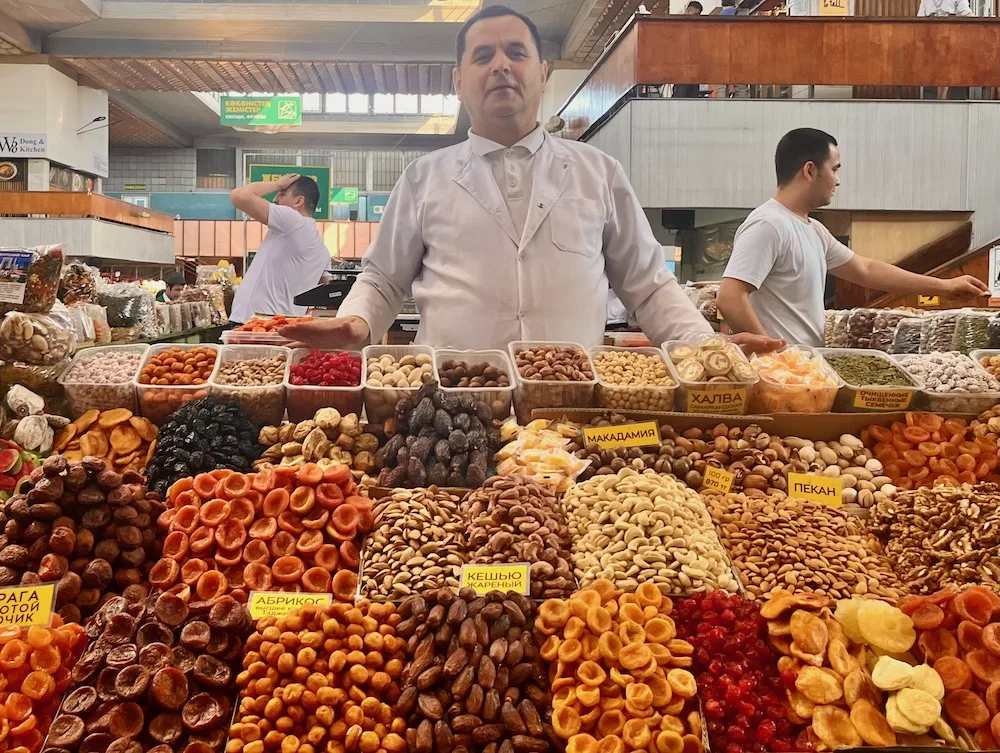
What travel health issues do I need to know about?
Vaccinations: I didn’t get any shots specifically for this trip. The CDC recommends hepatitis shots in addition to all routine childhood vaccinations. And it recommends at least one MMR shot for babies older than six months who haven’t had one yet.
It’s a good idea to make sure your tetanus shots and Covid-19 vaccinations are up-to-date.
If you’re planning to do extended travel or spend a lot of time in rural areas the CDC suggests vaccines for typhoid, tick-born encephalitis and rabies, too.
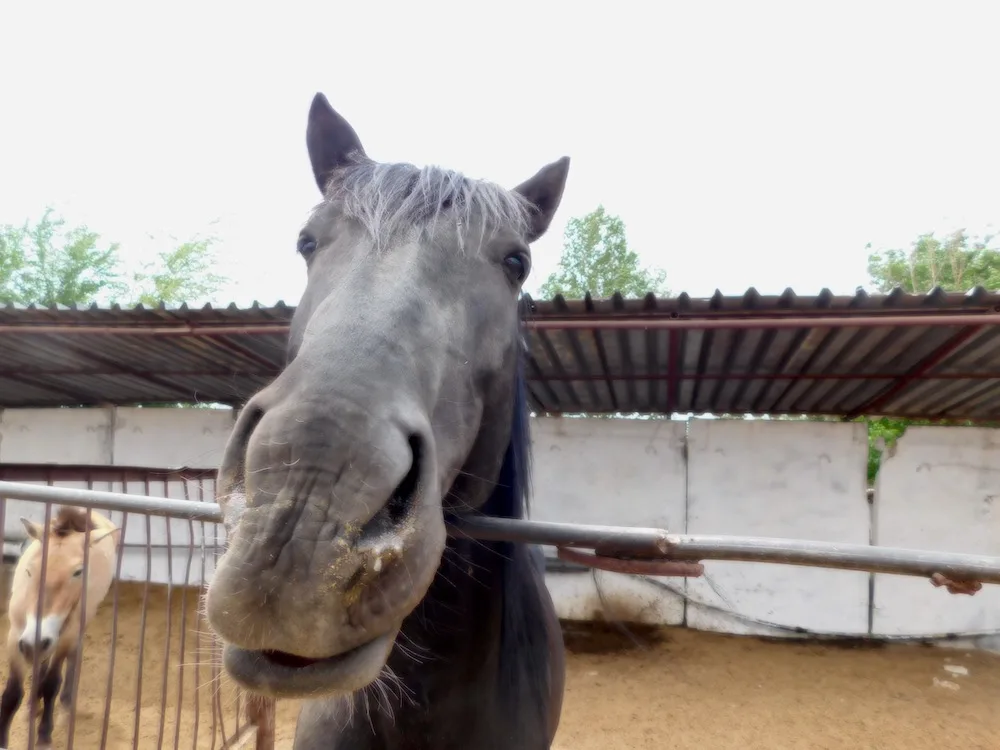
Animals: We happened upon some nice horses and cute dogs on one of our day trips, but I resisted petting them. I would discourage kids from petting animals, especially dogs, which are almost certain to have ticks and possibly fleas.
Water: I’ve read mixed things about whether tap water is safe in Almaty and we stuck to bottled water there (though I did brush my teeth with tap water). Outside of Almaty you’ll want to use bottled water for everything because of concerns about water-born illnesses, old pipes and too many heavy metals and minerals in the tap water.
If you’ll be in rural areas a lot bring a water bottle with a nano-filter, like the ones Grayl makes, or something similar.
• Probiotics: I took probiotics leading up to and during this trip. Even if it’s benign, unfamiliar bacteria can wreak havoc on your digestion. It seemed like a good bit of insurance against raw fruit, salads, and all the dried fruit and nuts I sampled in the markets. Also, I think most of their dairy is pasteurized, including the camel milk, but possibly not some cheeses. And items that are fermented are not.
It’s always a good idea to pack some over-the-counter medication for minor gastro-intestinal issues. And in the cities you can easily find a pharmacy or chemist if you need one.
• Tips on Toilets: When you’re traveling outside of the cities use restaurant and hotel bathrooms whenever you have the chance. The large gas stations with convenience stores will have reliably clean bathrooms with western toilets, too.
In the national parks and other rural areas you’ll encounter at least a few squat toilets, which are intimidating if you aren’t used to them. And there might or might not be a sink that works. If you have to pay for the bathrooms they’ll provide you with toilet paper to take in with you. It’s common to not be able to flush the paper (the rural pipes can’t handle it). When you can’t you’ll see a basket in your stall for disposing of it.
• Hand sanitizer: You’ll absolutely want to keep hand sanitizer with you. If I went back I’d keep a packet of wet wipes or tissues in my backpack, too.
What is the Kazakh currency & what do things cost?
The local currency is the Tenge and the exchange is 400 to 450 Tenge to the dollar. You can exchange money at the airport and we found ATMs in the mall across from our hotel.
Aside from the flight over you’ll find a vacation in Kazakhstan to be pretty budget-friendly, especially if you stick to local shops and restaurants.
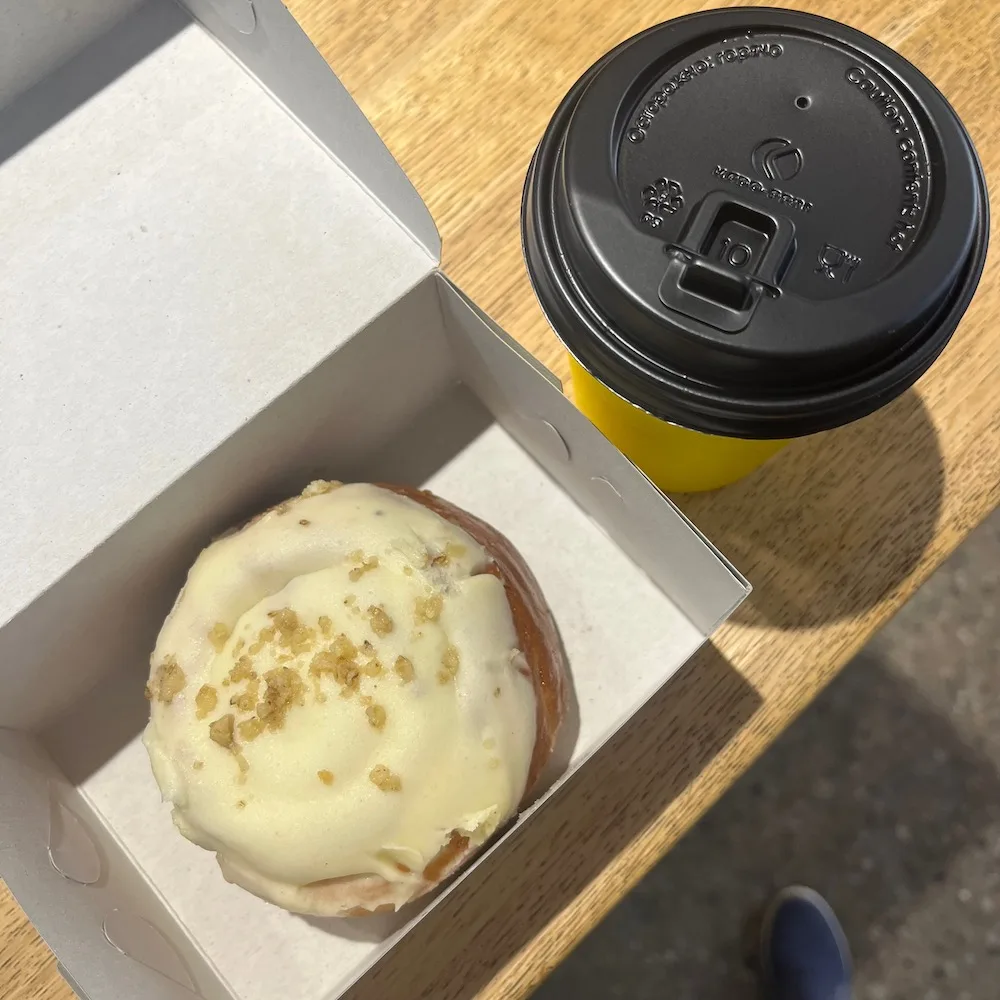
An iced latte at the Western-style mall by our hotel cost $3 to $5, but coffee and a small apple pastry at a local café was about $2.50 altogether. At the central market a cappuccino and large pistachio roll cost me about $3.50.
A standard bottle of water is about 50 cents. An imported beer at our hotel bar was $8 to $10, but a local beer in a restaurant was $1.50. A cone of gelato was about a $1.
A meal in a casual restaurant will be $5 to $10 per person and a mid-range restaurant will run you $15 to $20 per person. Fast food could cost less than $5 per person.
A room at an Ibis or Holiday Inn Express will cost less than $100. You can reliably find a four-star hotel with breakfast, a pool, a helpful front desk and a good location for $120 to $200.
The subway costs about 25 cents. A two-mile cab ride was not quite $4.
How Do I Get To Kazakhstan & How Do Tourists Get Around?
Americans and Canadians don’t need visas to enter Kazakhstan for 30 days or less.
Most flights to Almaty connect through Frankfurt, Doha or Istanbul. From the West Coast you can sometimes connect through Seoul as well.
Travel time between New York and Almaty can be 22 to 28 hours each way depending on how many connections you have and how long the layovers are. The flights from Frankfurt used to fly across the Ukraine and Russia; having to go around their closed airspace adds a few hours to that flight. Sometimes flights to or from Almaty will touch down in Astana briefly, which adds about two hours to the trip.
Air Astana is buying planes and working out the details for direct flights from New York City. That would cut the flight time to about 17 hours. Look for those flights in late 2024 or early 2025.
If you plan to explore more than one region, book internal flights between cities. Astana is barely two hours from Almaty by air but would take more than 16 hours to drive and up to 24 hours by train.
For getting around the city, there is the subway, which is cheap and fast but has only one train line at the moment. I saw public buses on the major boulevards and I think they would be easy enough to figure out if you have the time.
There’s a local Taxi app, where you bid for your ride. It’s entirely in Kazakh and not easy for foreigners to use. But the front-desk staff at my hotel used it to book a taxi for me and told me how much it would be.
As with Lyft, the app tells the taxi driver where you want to go, too, which is handy if you don’t speak Kazak. Plan to pay cash at the end of the ride. Tipping isn’t expected, but I rounded the fare up to the next hundred Tenga for convenience.
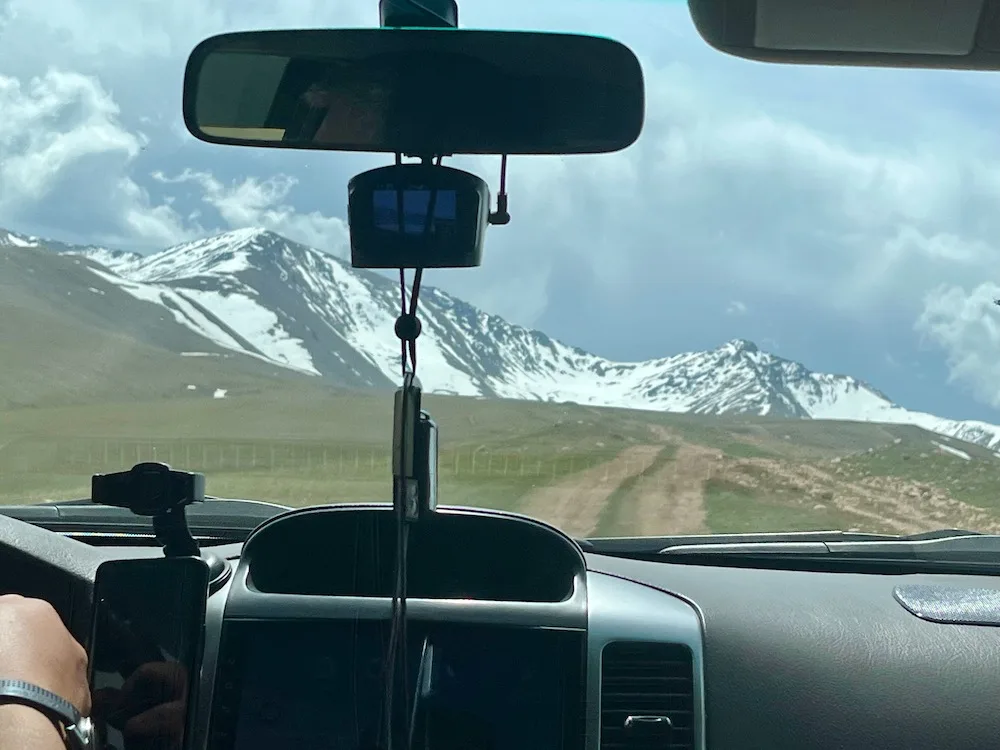
Some of the day trips we took involved driving on rough dirt roads and barely discernible tracks. There were also a lot of narrow mountain roads. Even if you’re very intrepid, I recommend booking tours for these excursions and letting a local pro do the driving.
Should I bring a car seat?
Kazakhs are fairly lax when it comes to their own seat-belt use and I would not rely on tour companies or taxis to have car seats you can borrow. But all the tour buses and cars I was in were reasonably new and had seat belts. We were shaken around like dice in a cup on some of the back roads and definitely made use of them for ourselves.
If your baby still uses a rear-facing car seat I would suggest bringing one you can secure with a seatbelt. Convertible car seats and most full-size boosters would make your child too cramped in the tour buses and vans I was in. But a travel booster like the ones from Bubble Bum or Hiccapop will come in very handy.
A tip for cellular service
I needed reliable cell service on this trip, to keep in touch with home and to post photos and videos to social media during long bus rides. But I didn’t want to pay $10/day in roaming fees. A few of my fellow travelers introduced me to Airalo and it was a where-have-you-been-all-my-life moment.
Airalo is an app that provides virtual SIM cards, so you can access a local data network without having to replace your actual SIM card and risk losing it. I had all the data I needed for less than $5/week. Will I be using Airalo for all my overseas trips from now on? Yes, I will.
That Packing List:
Download and print it to get ready for your amazing Kazakhstan adventure:
Pin it for later!
